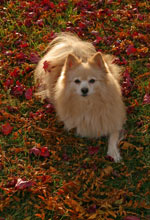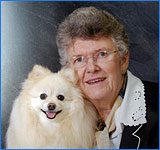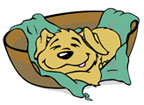Pomeranian Dog Breed
Dog Group: Toy Group
Class: Toy
Description

The Pomeranian, or Pom as it is sometimes called, is a very luxurious, fluffy little dog with a sharp, fox-like face and a very pretty, alert face. The coat of the Pomeranian is long and straight with a fluffed-up under-coat that makes the Pomeranian look like a ball of fluff. The coat comes in a variety of colors including white, black brown and blue, and can also come on bi-colors of white with colored patches. The neck area of the Pomeranian appears to have a fur ruffle, where the long hair frames the neck and head. This breed has very dark almond-shaped eyes that lend it an intelligent and alert expression, and its ears are small, triangular and erect.
Temperament
The Pomeranian is an energetic and lively little dog that enjoys learning and is always keen. This enthusiastic breed is very courageous for its small size, and is always loyal to its owner and family. Curious and cheerful, the Pomeranian sees itself as bigger than it is and will not think twice about going for a larger dog if necessary. This is an affectionate breed, but can get nervous and snappy. For this reason, the Pomeranian is not recommended for families with very young children that may tease it without knowing any better. Older children and adults will love this little dog.
Height and Weight
The Pomeranian is a very small dog, and reaches around 7-12 inches in height. The average Pomeranian will reach around 3-7 pounds in weight.
Common Health and Behavioral Problems
The Pomeranian may be at risk from luxating patella (slipping kneecap), eyes infections, skin problems and heart defects. This breed is also prone to oral problems and may lose its teeth far earlier than other breeds.
Ideal Living Conditions
The Pomeranian is an adaptable breed and will be equally as happy in an apartment with no garden as he would in a house with a large yard or garden. This dog loves company and play, so he will be happy living anywhere as long as he received plenty of attention and fuss from his owners.
Exercise Requirements
The Pomeranian loves to go for walks, and will happily play in the garden if there is one available. If not, you must ensure that you take him for regular walks to allow him to explore and satisfy his curious streak as well as to get healthy exercise.
Diet and Nutrition
The Pomeranian does not need a special diet, but because the breed is prone to tooth loss and oral problems a quality, dry food is recommended. Don’t be tempted to overfeed the Pomeranian – remember this dog is only small! Always provide plenty of fresh, clean water.
Life Expectancy
The life expectancy of a healthy Pomeranian is around fifteen years, although this will be affected by his overall health and lifestyle.
Grooming Requirements
The Pomeranian has a luxurious coat and does shed a lot, so grooming is a necessary and time-consuming task. You should brush the coat regularly and use dry shampoo as and when required. You should also take the opportunity to check the eyes and the mouth of your Pomeranian, as well as taking him for dental check-ups to maintain oral health.
Origin
The Pomeranian originates from Germany and this breed is though to be a descendant of the Spitz. The Pomeranian has been a firm favorite of high society, and Pomeranian ownership is something that Queen Victoria, Mozart and Marie Antoinette all had in common. The original Pomeranian was much large than the one we know today, weighing in at around thirty pounds. However, Queen Victoria’s love of smaller dogs is reputed to be one of the reasons why breeders decided to reduce the size of this dog through selective breeding. The American Kennel Club first registered the breed in 1887.
 |
 |
Secrets to Dog Training Testimonials
 "Hi, I am happy to be part of your custumers and I want to thank you for your advice, I have a five year old Pomeranian, of course she is not a puppy anymore, but she have to learn a lot, I tryed to call her before whenever she is in the house and she was just looking at me, let me tell you she is very intelligent, but I did not know how to teach her what I want, of course my commands are in French, but since I used your technique I saw quite a change, today I told my husband, have a look outside I'm loing out with Leesa and see the progress.
"Hi, I am happy to be part of your custumers and I want to thank you for your advice, I have a five year old Pomeranian, of course she is not a puppy anymore, but she have to learn a lot, I tryed to call her before whenever she is in the house and she was just looking at me, let me tell you she is very intelligent, but I did not know how to teach her what I want, of course my commands are in French, but since I used your technique I saw quite a change, today I told my husband, have a look outside I'm loing out with Leesa and see the progress.
I called her she was quite a way from me, she came in running and when she was closed to me I told "sit" assis in French, she answered right away, and I did the same exercise twice and she responds the same way. Can you imagine how proud I was, furthermore I want another dog this time I choose a Yorkshire, let me tell you that I'm anxious to use my book Secrets to Dog Training to learn more and more about dogs.
My husband and I have enough LOVE for two dogs, as long as they are well dressed. The picture was taken by a professional but I took a picture of it to send to you. Thank you."
-- Lyne Lavoie (Canada)
More Resources
 |
 |
Want to find out about more dog breeds? Search here or go to our Dog Breed index.
Got Dog Obedience Training or Problem Behavior Issues?
Is your dog trying your patience on a daily basis? Are you constantly faced with a dog that displays one of the following issues? To find the solution to your problem click on it.. you'll discover the answers to it and other common dog problems you may be facing.
This is the most comprehensive book on dog training and behavior problems around. Best of all... You can download this book to your computer and be reading and using the professionals training techniques in minutes.
About The Author
Daniel Stevens is the renowned dog trainer and author of Secrets to Dog Training: STOP Dog Behavior Problems!, one of the leading dog training guides on the market today selling over 25,743 copies (and counting). He currently heads the Kingdom of Pets dog training team.

